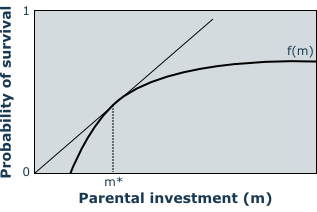Seeds: the size vs. number trade off
The size of seeds is closely related with the success of seedlings. Smaller seeds can however be produced in larger numbers, what favors dispersal over longer distances, particularly important in the patchy landscape of high mountains.
The evolution of seed size vs. seed numbers
Theoretical models (see Fig. 1) predict an optimum seed size for a given species with smaller seeds being inviable or having low fitness and with seeds beyond the optimum having a size-independent establishment success. Seeds bigger than the optimum waste maternal resources that could be used better by provisioning more seeds and thereby fitness.
Seed size of alpine species
Baker (1972) argued that alpine plants have smaller seeds, because they can devote fewer resources to sexual reproduction than lowland plants due to the short growing season. On the other hand, selection should favor larger seeds because larger seeds have a better chance in harsh alpine habitats. This view is supported by observation from Landolt (1967) and several more studies that compared seeds from lowland taxa with the seeds of their congeners occurring at higher altitudes.
Schütz and Stöcklin (2001) found seeds of alpine Asteraceae and Apiaceae to have significant larger seeds than their lowland relatives. At the genus level such an increase was found in 6 genera (e.g. in Juncus and Carex), while in 3 genera the opposite was found. The opposing trends in seed size with altitude are probably not so surprising because seed weight co-evolves with other characters not necessarily integrated similarly in different families and genera.


